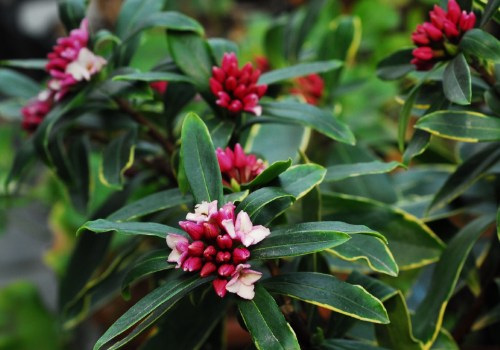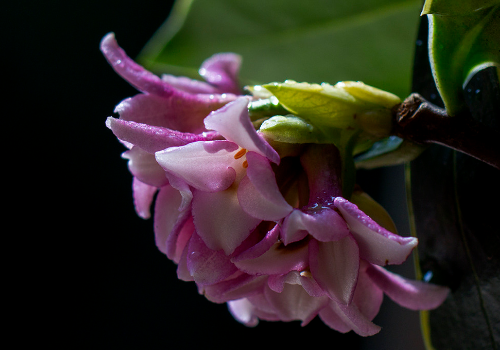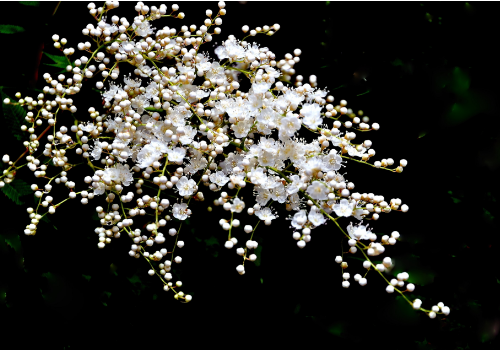How to maintain after growing flowers in Phnom Penh Ruixiang in winter
Phnom Penh incense blossoms every spring and usually blossoms only once. How to raise Ruixiang in Phnom Penh in winter? How to maintain after blooming:
How to raise Ruixiang in Phnom Penh in winter:
1. Move indoors
The safe overwintering temperature of Ruixiang in Phnom Penh is above 5 ℃, so it can be placed in the south window to receive sunlight during the day, and the window can be opened for ventilation in sunny days, and it has to be moved to a place with higher indoor temperature at night, because the outdoor temperature is low at night, so it is possible to frostbite even if the window is closed.
2. Fertilization
If the potted soil of Phnom Penh Ruixiang does not apply base fertilizer at first, then it should be fertilized frequently, but not raw fertilizer or concentrated fertilizer, you can choose soybean water or potassium dihydrogen phosphate solution. Don't let ants, earthworms and other animals appear in the soil.
3. Watering
The growth rate of Phnom Penh incense is relatively slow in winter, so the amount of water should be controlled. Usually we can tell whether the amount of water is appropriate from the feedback of the leaves, if the leaves are straight and straight up, it means that the water and fertilizer is normal; the leaves are drooping, indicating that they are watered too much or too often. If too much watering produces stagnant water, it can easily lead to rotting roots.

How to take care of Phnom Penh Ruixiang after blooming:
1. Brightening and cooling
When they bloom, they will bloom very luxuriantly, and put them in a place with light at this time to make the flowers more fragrant. And a flower to silk. At the same time, properly reducing the temperature of its living space to about 5 degrees Celsius can prolong the florescence and let Phnom Penh Ruixiang show its beauty for a longer time.
2. Pruning branches and leaves
This kind of flower has strong germination ability and can be pruned properly after flowering, which has made its appearance more beautiful and enhanced its growth. As a result, they can then use scissors to remove branches and leaves that are underdeveloped, overgrown or not conducive to overall beauty, making them look more stylish.
3. Avoid diseases and insect pests
When Phnom Penh incense blossoms, the roots can give off a good smell, which is easy to attract ants, earthworms and so on, so it is necessary to control its insect pests. In addition, mosaic disease caused by virus can also threaten the normal growth of Phnom Penh after flowering. The disease will make its leaves grow excellent spots and deformation, resulting in the failure of normal flowering and growth. Therefore, once the symptoms of mosaic disease are found, it should be eradicated in time and burned so as not to spread.
Do you have any questions about the maintenance of Ruixiang in Phnom Penh?
How to raise Daphne odora in winter in Phnom Penh
Winter maintenance method of Daphne odora in Phnom Penh
Place a site
Since Frosts Descent, Phnom Penh Ruixiang should be moved to indoor maintenance. Put it in the south window to be exposed to the sun during the day, and move to a place with higher indoor temperature at night, not by the window, so as to avoid frostbite. Ensure that the indoor temperature is above 5 ℃ in winter and open windows for ventilation when the weather is clear.
Fertilization requirements
There can be no base fertilizer in the potted soil of Phnom Penh Ruixiang, and liquid fertilizer should be applied frequently. However, it should be noted that there should be no ants and earthworms in the potted soil. (although earthworms help to enhance the fertility of the soil, the presence of earthworms in family potted plants is still a bit disgusting. ), fertilization would rather be light than thick.
Liquid fertilizer mainly chooses soybean water or potassium dihydrogen phosphate solution. When fertilizing is too dense, it can be watered in time and poured several times in a row to let the fertilizer flow out from the bottom of the basin and reduce fertilizer damage, and then put the basin in a ventilated place to let the basin soil dry as soon as possible.
Watering method
The growth of Phnom Penh incense is relatively slow in winter, so watering should be based on the situation. If the leaves are straight and straight up, it means that the water and fertilizer is normal; if the leaves are drooping, it means that they are watered too much or too often. Find the cause and correct it in time.
If the rotten root is caused by too much watering, it should be dealt with in time, take off the plant in time, cut off the rotten root, wash it with fungicide, and then replant it. Of course, in order to make the plant recover as soon as possible, we can cut off part of the upper leaves to reduce nutrient consumption.
What about the winter buds of Ruixiang in Phnom Penh?
The florescence of Daphne odorifera in Phnom Penh is mainly in winter, but the winter environment is bad, and it is easy to drop buds if it is not properly maintained. We should make preparations in advance and pay attention to a few points:
Temperature control
Phnom Penh Ruixiang likes warmth and can't stand the bright light. Excessive sunlight and low temperature will cause buds to fall. In addition to controlling the temperature, it is also necessary to note that in a stuffy environment, Phnom Penh Daphne is easy to suffer from mosaic disease, which will cause a large number of buds falling, so it is necessary to spray Bordeaux solution in time to prevent and cure it.
Fertilizer application
After entering the autumn, we should pay attention to fertilization, apply thin fertilizer frequently, until the buds bloom. Before the formation of the bud, it is mainly phosphate fertilizer; after the bud formation, it can be replaced by potassium dihydrogen phosphate solution, foliar spraying, or root irrigation, fertilizer and water should be sprayed evenly to estimate the positive and negative sides of the leaf. So before winter comes, the buds have grown steadily on the branches, so there is no need to worry about falling buds!
Phnom Penh Ruixiang potted plant management, Phnom Penh Ruixiang picture appreciation
Phnom Penh Daphne belongs to the evergreen shrub of Daphne odora. It is a variety of Daphne. No matter when it is, the planting of plants is a kind of technical work for examiners, which requires not only knowledge, but also enough patience and care. Then let's take a look at the pot management of Phnom Penh Ruixiang with Xiaobian. Phnom Penh Ruixiang potted plant management Phnom Penh Daphne has a strong fragrance, like semi-overcast or sunny ground, avoid scorching sun exposure and rainstorm. Phnom Penh Daphne has poor cold resistance and is not resistant to waterlogging, so it is suitable to grow in fertile, loose and slightly acidic soil with good drainage, so it adopts a relatively extensive management mode in normal management. The propagation method of Phnom Penh Daphne mainly adopts cutting propagation, and the part of cutting is old wood and tender twig. this method has high survival rate, easy to learn, labor-saving and potted Phnom Penh incense. Pot soil should be mixed with loose, humus-rich slightly acidic rotten leaves or mud (or frozen crisp pond soil), mixed with appropriate amount of river sand and mature cake fertilizer. First, pot soil potted Phnom Penh Daphne should be of moderate size, and it should be planted shallowly in soil with humus and loose and sour soil. The ratio of basin to soil is 4 ∶ 4 ∶ 2 for garden soil ∶ rotten leaf soil ∶ sand. After the potted soil is prepared, it is sterilized under the exposure of the sun. Second, change the basin Phnom Penh Daphne usually change the basin soil once every two years, and change the basin when the early spring bud is not sprouting. After removing the pot, remove the outer soil of the root, pay attention to the soil, add newly cultivated soil to plant, the planting depth is the same as the original depth, if the plant of Phnom Penh Daphne is larger, you should change the big pot. After planting, the basin soil is compacted, watered thoroughly, and maintained in a cool and ventilated place for 10 to 15 days, normal maintenance management can be carried out. Third, watering Phnom Penh Daphne leaves contain a lot of wax, so Phnom Penh Daphne leaves transpiration is very small, so it is not resistant to moisture, usually watering should be dry and wet. At the beginning of spring, the buds were watered once when they were about to sprout, and then poured thoroughly after the basin soil was dry. In summer, in addition to keeping the basin soil dry and wet alternately, it is also necessary to spray water around it and leaves regularly to cool down. The late autumn makes the basin soil in a semi-dry state, which slows down the growth potential, which is conducive to overwintering. When the growth stagnates in winter, the basin soil should be dry and watering should be less. Fourth, fertilization Phnom Penh Ruixiang does not like big fertilizer, under normal circumstances, usually once a month to apply mature thin fertilizer solution. The application of thin fertilizer solution before and after flowering can make the plant luxuriant and the flower fragrant and colorful. Fertilizer precautions: ① do not splash the fertilizer on the leaves. ② fertilization should be carried out when the basin soil is dry. ③ does not apply human faeces, urine and chemical fertilizers. Fifth, pruning and pruning Phnom Penh Daphne has strong germination and resistance to pruning, and can be pruned according to the required plant shape after flowering, mainly removing weak branches, over-dense branches and so on. 6. In the spring of reproduction, take the top 8 cm to 10 cm of the last branch, leave 2 to 3 leaves at the top, dip them in rooting powder, insert them into the cutting substrate, insert the cuttings with a depth of 1 beat 2 to 2 10 cm, pour water thoroughly, and keep the cutting substrate moist and dry, rooting in about 20 days. In summer, the cuttings were cut in the same year, and the insertion depth was about 1x2 of the cutting. after the cuttings were watered, the cuttings were kept moist and dry, but the leaves should be sprinkled frequently until they took root. In addition, it can also be grafted and propagated under high pressure in spring, summer and autumn. Seventh, the root of preventing and curing Phnom Penh Daphne is fleshy aromatic root, which is sweet and vulnerable to bacteria, especially earthworms. It can be killed by disinfecting soil or smashed garlic and buried in basin soil. High temperature and rainy summer, easy to give birth to mildew, put the basin in the place of air circulation, can prevent the occurrence of mildew. 8. Other related points for attention: 1. Shade or move to a shady place in summer and early autumn, so as not to let the strong light shine directly. Winter should be cold-proof, indoor not less than 0 ℃, subject to non-icing. 2. Avoid heavy rain, and the wet soil will cause rotten roots. 3. When flowering, give Phnom Penh Daphne proper light, can make the flower fragrance thicker, properly lower the temperature (about 5 ℃), can prolong the flowering period. Conclusion: the above is the relevant information about the pot management of Phnom Penh Ruixiang. Do you all remember it? The editor's information is not comprehensive enough, so please forgive me. Different plants have different planting methods, and different details also determine the key to success or failure.
- Prev

Can Phnom Penh Daphne be cultured in water? how to cultivate in water?
As a well-known traditional flower plant in China, Phnom Penh Daphne has always been loved by people. Can Phnom Penh Daphne be hydroponically cultivated? How to hydroponics: can Phnom Penh Daphne be hydroponized? although hydroponics is a popular way of potted plants at present, it is not only easy to operate, but also beautiful and clean. Phnom Penh Daphne can also be maintained by hydroponics.
- Next

How to cultivate Pearl Plum and matters needing attention
Pearl plum can not only be cultivated outdoors as tall flowers and trees, but also can be cultivated in the balcony or courtyard. How to raise pearl plum? Breeding methods and matters needing attention: how to raise pearl plum: 1, select the basin. Potted plants use 20-30 cm diameter flowerpots. Use far soil in basin soil
Related
- Fuxing push coffee new agricultural production and marketing class: lack of small-scale processing plants
- Jujube rice field leisure farm deep ploughing Yilan for five years to create a space for organic food and play
- Nongyu Farm-A trial of organic papaya for brave women with advanced technology
- Four points for attention in the prevention and control of diseases and insect pests of edible fungi
- How to add nutrient solution to Edible Fungi
- Is there any good way to control edible fungus mites?
- Open Inoculation Technology of Edible Fungi
- Is there any clever way to use fertilizer for edible fungus in winter?
- What agents are used to kill the pathogens of edible fungi in the mushroom shed?
- Rapid drying of Edible Fungi

